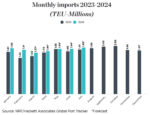Archives
Business, Freight News, Logistics, Sea
Import Cargo Returning to Normal: NRF
[ March 14, 2024 // Gary G Burrows ]Inbound cargo volume at major U.S. container ports is expected to show year-over-year increases through the first half of 2024, according to the Global Port Tracker report released March 8 by the National Retail Federation and Hackett Associates.
Supply chains are adjusting to ongoing Houthi rebel attacks on commercial vessels in the Red Sea, and inbound volumes are returning to normal, NRF said.
“Cargo has been rerouted and goods are arriving where they are needed and in time to meet consumer demand despite the ongoing challenges,” said Jonathan Gold, NRF’s vice president for supply chain and customs policy. “Retailers have been impacted by costs and shipping delays, but they are working to minimize any impact on consumers.”
Carriers are avoiding the Red Sea and the initial surge in shipping prices and delays is subsiding, Hackett Associates Founder Ben Hackett said. Some cargo has shifted from Asia via the Red Sea and Suez Canal to instead the U.S. East Coast via the Cape of Good Hope. Cargo shipped across the Pacific to the West Coast has also improved, while some ships are traveling across the Pacific and through the drought-challenged Panama Canal to reach the East Coast.
“Fear of an inflationary impact due to the raised cost of transportation should be alleviated by now,” said Hackett, who’s eponymous company provides expert consulting, research and advisory services to the international maritime industry, government agencies and international institutions. “Retailers and their carrier partners are adjusting to the re-routings and new schedules, which add new costs but those can be partially offset by not having to sail up the Red Sea and not having to pay Suez Canal transit costs. This will continue until there is a resolution and freedom of navigation through the Red Sea and Suez Canal.”
The 13 U.S. container ports covered by Global Port Tracker handled 1.96 million 20-foot equivalent units, or TEUs, in January, the latest month for which final numbers are available. That was up 4.7 percent from December and up 8.6 percent year over year.
While ports have not yet reported February’s numbers, Global Port Tracker projected 1.9 million TEUs, up 22.7 percent year-over-year. March is forecast at 1.77 million TEUs, up 8.8 percent from last year. February is traditionally the slowest month because of Lunar New Year factory shutdowns in Asia but the timing of the holiday and its impact on cargo and year-over-year comparisons varies.
April is forecast at 1.84 million TEUs, up 3.1 percent year over year; May at 1.94 million TEUs, up 0.5 percent; June also at 1.94 million TEUs, up 5.7 percent, and July at 1.99 million TEUs, up 3.8 percent.
The first half of 2024 is expected to total 11.5 million TEUs, up 7.8 percent from the same period last year. Imports during 2023 totaled 22.3 million TEU, down 12.8 percent from 2022.
Global Port Tracker, which is produced for NRF by Hackett Associates, provides historical data and forecasts for the U.S. ports of Los Angeles-Long Beach, Oakland, Seattle and Tacoma on the West Coast; New York-New Jersey, Port of Virginia, Charleston, Savannah, Port Everglades, Miami and Jacksonville on the East Coast, and Houston on the Gulf Coast.
NRF is the world’s largest retail trade association. Retail is the nation’s largest private-sector employer, contributing US$3.9 trillion to annual GDP and supporting one in four U.S. jobs.

Tags: Hackett Associates, National Retail Federation









